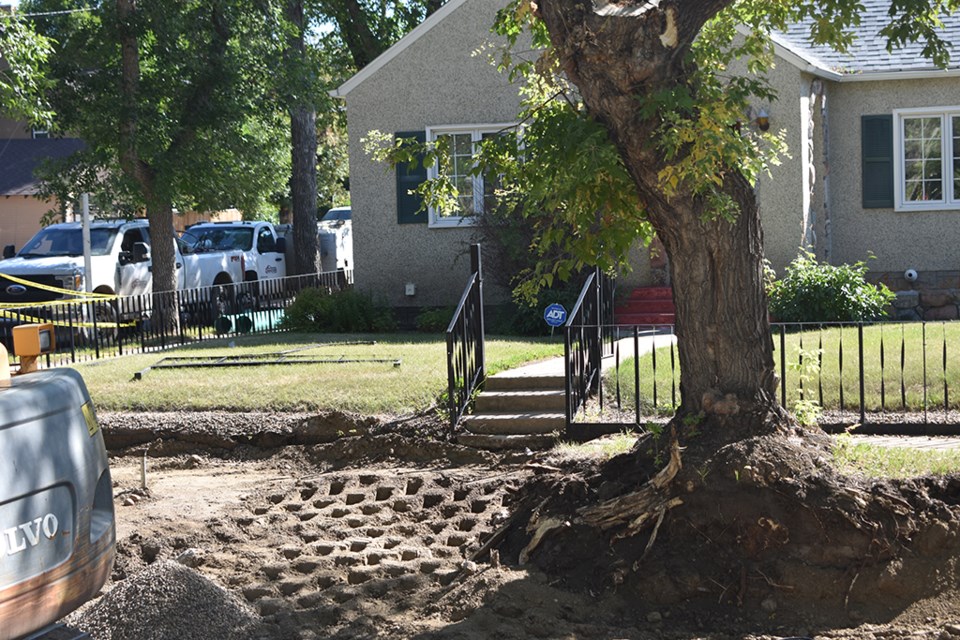NORTH BATTLEFORD — John Voit, an arborist of over 30 years and a concerned resident living in North Battleford is sounding the alarm over what he believes is a dangerous lack of maintenance and care of trees in the City of North Battleford.
Citing examples of damage to structural roots along sites of former and current underground pipe and asphalt replacement (UPAR) renovations, damaged bark, and lack of maintenance of deadwood branches among trees in various parts of the city, Voit is calling on the city to fix something before it's too late.
"There's a standard that we go by in the arboriculture industry if 30 per cent [of the roots] are damaged, the tree is classed as being at hazard," Voit told the News-Optimist.
Voit alleges that although the City of North Battleford has an existing arborist that replaced him upon Voit's retirement in 2007, the position is not being used as it should be to preserve trees in the city.
"And they blame this on, of course, budget cuts, there are not enough people to go around ... But over the years, they've been cutting these budgets so much that they (arborists) cannot take care, and they cannot give advice on what's very, very important to this community, and that is a condition of the trees."
Voit highlighted that healthy trees in the city are essential as they consume CO2. He noted that the consumption of CO2 will help with cleaner air in the city as severe weather patterns and more wildfires make for more wildfire smoke, but also that these trees may pose a danger to residents.
"And if they're (the City of North Battleford) not going to keep up with the proper maintenance on these trees, and they're dying at a very quick rate around the city, then our air quality is gonna go down further. Once these trees die, they cannot store that carbon anymore," he said.
"The city is setting itself up for some liability situations. Because under the proper weather conditions, with 50, 60, 70 per cent of the root system gone, [with] three inches of rain and a big wind, some of these things are going to start toppling over ... They're going to do some damage. You know, if there's a car parked here, if there's someone out mowing in their grass, you know, what's gonna happen?" he added
Voit noted that his remarks aren't aimed at the arborist himself, who he says is good at his job, but instead at the city, which he feels isn't doing its duty to protect citizens or the environment.
"Anywhere you drive in this city, just look up ... you will notice a lot of the deadwood in the trees, and this is, again, mismanagement of our arborist," Voit said, adding, "...and the proper care of trees."
Keith Anderson, the executive director of the prairie chapter of the International Society of Arboriculture, told the News-Optimist that there is a strong concern that the city is failing to preserve urban forests, again creating a liability that could harm residents.
He noted that arboriculture industry standards would require less than 30 per cent of structural tree roots to be damaged, with some root damage on trees in the city exceeding 70 per cent and being left standing.
"The amount of root loss that is significant enough to affect stability varies with tree species maturity and crown size ... when a third or more of the trees buttress roots are missing, that's where the roots arise from the trunk and go into the ground. So that's your structural root system, that's where the structural root system begins," Anderson said,
"So when a third or more of the trees, buttress roots are missing, or significantly decayed, stability can be significantly reduced."
Anderson added that there are other options that don't involve damaging trees, as seen in other cities such as Saskatoon or Edmonton, especially in a time when governments are expected to be caring for and planting more trees.
In an email statement, Randy Patrick, the City of North Battleford's city manager, told the News-Optimist that the city has engaged its on-staff arborist on all UPAR projects, with the arborist assessing the state of trees in the UPAR project zone throughout the duration of the construction period.
"The 98th Street project zone has very deep trenches to accommodate the replacement of aging infrastructure, and this street is quite narrow in width. Tree roots can sometimes be compromised during construction, but the long-term impact on a tree is not always immediately evident," reads the statement.
"Administration accompanied the City’s Arborist as recently as Monday of this week [Aug. 14] to review the state of the trees on 98th Street ... the City’s Arborist will continue to evaluate the health of the trees on 98th Street within the UPAR project zone over the next 3-5 years to ascertain their long-term health and structural well being.
"During that time, if any tree is found to be unhealthy or compromised, risking public safety, it will be removed."
The statement noted that the city hopes to maintain the character of city neighbourhoods and preserve as many trees as possible, but administration takes its direction from its certified arborist when the safety of the public may be at risk.
"Therefore, if the city’s arborist deems a tree unstable and unhealthy, the city will follow the direction provided by the arborist and have it removed to ensure public safety."




